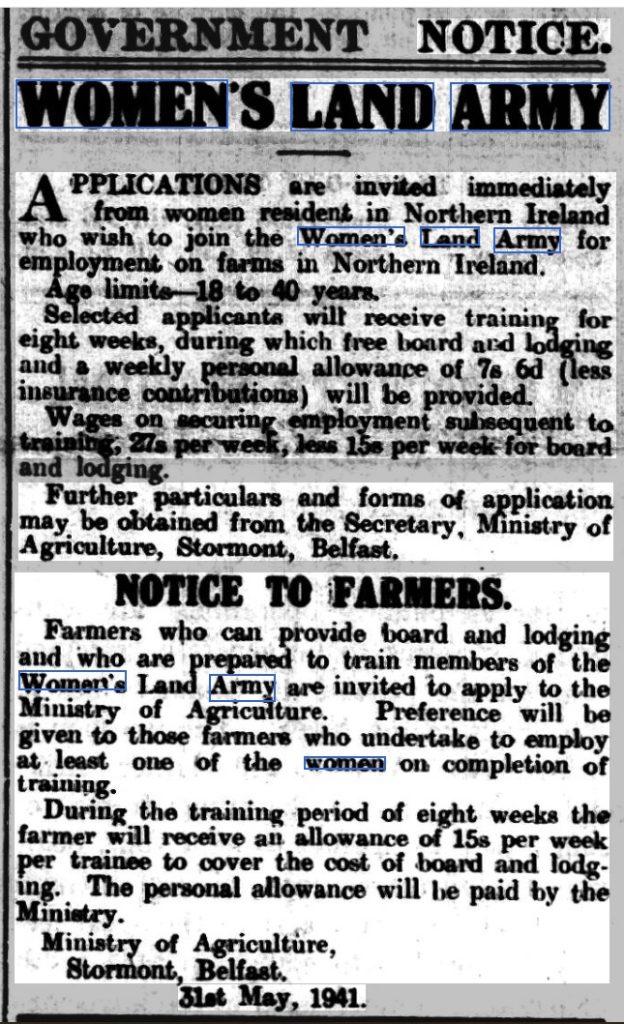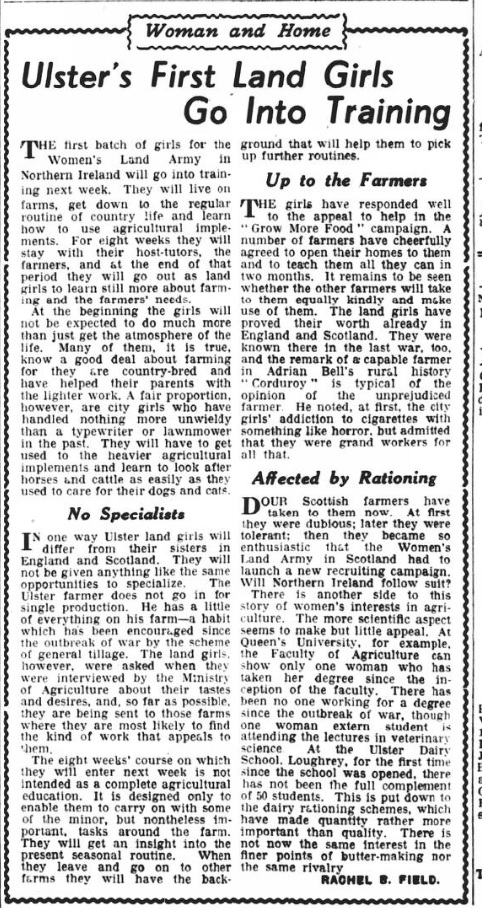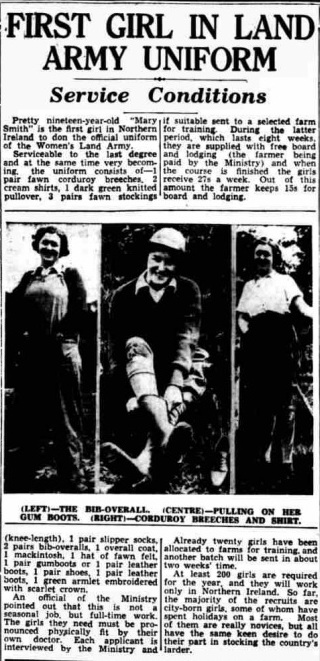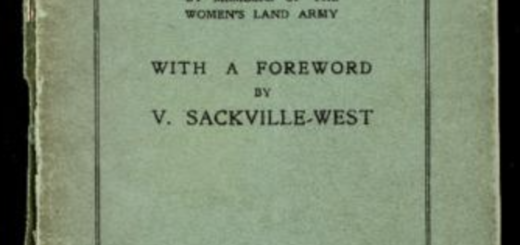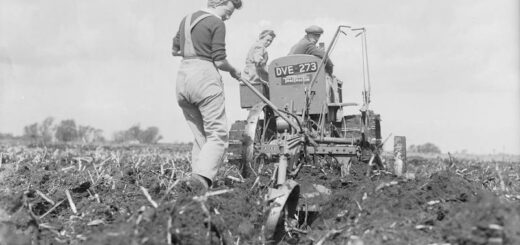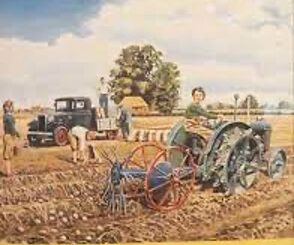The Women’s Land Army in Ulster, 1939-1945
The Women’s Land Army (WLA) in Ulster or as I will refer to it, the ‘Ulster Women’s Land Army’ (UWLA), came into being in early 1941 when the Ministry of Agriculture in Northern Ireland proposed that:
There now exists a considerable number of openings on farms in Northern Ireland which could be filled by women workers who have received some preliminary training on the lines of that provided in England by the Women’s Land Army.
In this note from the Ministry of Agriculture, the writer states that they now proposes that a branch of the Women’s Land Army be ‘inaugurated by this Ministry forthwith’ like the WLA in England. Even though the UWLA was formed as late as 1941, there had been some earlier discussion in 1939 of training girls at the Ulster Dairy School in light farm work such as poultry keeping, milking cows, and market gardening.
However, it was not felt that there would be a great need for WLA branch in Northern Ireland. Yet, by 1941 the increasing shortage of food meant that a Northern Ireland branch was established and run by the Ministry of Agriculture, rather than county committees like in England and Wales. It was due to the small size of Northern Ireland, and the small amount of UWLA members, that county management committees did not seem like a clever idea.
The training of prospective members of the UWLA was to take place at the Ulster Dairy School, near Loughry, in County Tyrone. Land Girls trained for an eight-week period, rather than the four to six week training period undertaken by the Land Girls in England, who were lucky enough to receive training. The shorter training of UWLA women was due to the smaller farms in Northern Ireland which had less specialised work for women to carry out.
Even though the UWLA was formed as late as 1941 in Northern Ireland there had been earlier talk of training girls at the Ulster Dairy School in light farm work such as poultry keeping, milking of cows, and market gardening as in 1939 it was not felt that there would be a great need for a WLA branch in Northern Ireland.
However, by 1941 with the increasing shortage of food a branch was established which was organized and managed by the Ministry of Agriculture rather than county committee’s like in England and Wales. Again, it is due to the small size of Northern Ireland that county management committee’s did not seem like a clever idea due to the small amount of UWLA members.
Recruitment for the ULWA began in earnest with newspapers across the country, with advertisements advising women who were interested in joining to contact the Ministry of Agriculture for further details on uniform, pay, and training. Although the UWLA was not managed by the WLA in England, the uniform of the UWLA was identical to their English counterpart. The uniform consisted of:
- One mackintosh
- One overall coat
- One pair of corduroy breeches
- Two shirts
- One knitted pullover
- Three pairs of stockings
- One pair of slipper socks
- Two pairs of dungarees
- One hat
- One pair of gumboots
- One pair of shoes or leather boots
- One green armlet embroidered with a scarlet crown
Interestingly the uniform of the UWLA did not consist of a great coat or slouch hat worn by the WLA in England, Wales, and Scotland. I have been unable to find out why women in the UWLA did not receive these items, but it was felt within the Ministry of Agriculture that these women may never take part in an official wartime parade or that farm work made these clothes impracticable.
Once the recruits received their uniform and had undertaken the requisite eight-week course at the Ulster Dairy School, they were expected to find their own billets and working arrangements on farms across Ulster. Again, this is one key differences between the UWLA and WLA, as members of the WLA were not expected to find their own billets and working arrangements.
As the war progresses, unfortunately archival and newspaper sources become less dependable and murkier, with little official detail on whether the UWLA was successful and whether members eventually found fulfilling farm work. Archival sources state as late as 1946, the Ministry of Agriculture was considering continuing the UWLA albeit on a smaller scale than the war, giving the impression that the UWLA must have been a success.
The Belfast Telegraph of Friday 13th June 1941 reports on Northern Ireland’s first Land Girl ‘Mary Smith’ in her ‘serviceable…. yet becoming’ uniform whilst undertaking training for the ULWA. Mary Smith’s name is in inverted commas, as the journalist implies that this is not the girl’s real name, though why she needs to protect her name under a pseudonym is unclear.
Finding names of UWLA Land Girls has been an ongoing problem throughout my research as I have been unable to find any names for the women who joined the UWLA. Either there are other archival sources that I need to find, or their names were not recorded for prosperity. Additionally, it is also important to note that women from Northern Ireland, and Southern Ireland, also joined the WLA in England, Scotland, and Wales.
My research on the UWLA is an on-going process as new archival sources become known, I can add more information to my research and in turn expand people’s knowledge on the UWLA. I hope that in the future that the UWLA will not be a forgotten part of Northern Ireland’s Second World War history but an integral part of it.
Biography
Rachel Sayers is an early career dress historian, curator, and blogger currently working at the Public Record Office of Northern Ireland. Rachel has worked for the HMS Belfast, Marks and Spencer Company Archive, and both The National Trust, and The National Trust for Scotland. Rachel’s interest in dress history centres on early to mid-twentieth century Irish dress history through the lens of social, domestic, and leisure history. Rachel also has an interest in the role Irish women played during World War Two particularly in the Women’s Land Army and the Women’s Royal Naval Service.
Bibliography
The Newsletter, 1938-1950.
The Belfast Telegraph, 1938-1950.
The Larne Times, 1938-1950.
FIN/18/19/461 – Ulster Dairy School (Women’s’ Land Army) Proposal to train a number of women in general farm work -1939-1943. Public Records Office of Northern Ireland, Belfast, Northern Ireland.
A Century of Women – 1940s – A Century Of Women (Website).
Maria Moyinhan, ‘The Irish land girls who fed and farmed Britain during World War II 12 March 2014 Premium (farmersjournal.ie)’, 2014.
